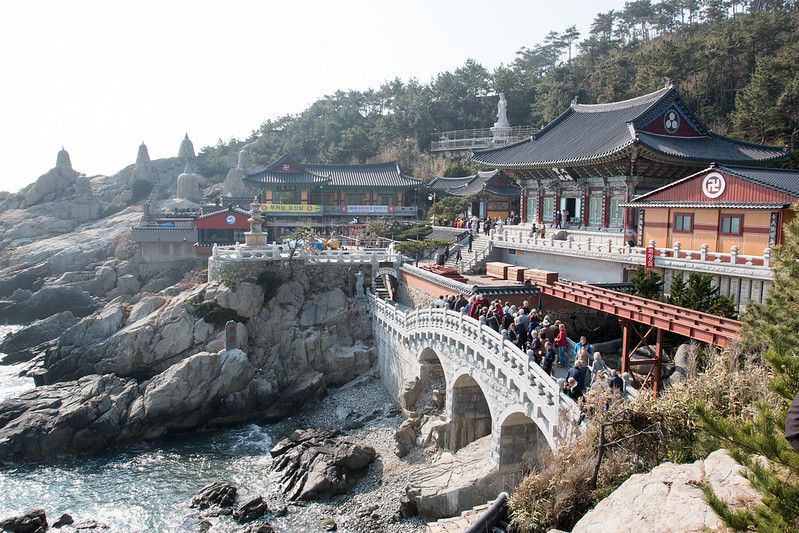When visiting Korea, there’s no doubt that Busan will be on your list. After all, Busan is the second largest city in Korea. It is also Korea’s largest sea port, with a population of over 3.6 million people. Its riches are endless, bountiful beaches, fun festivals and quiet nature reserves. With so much to do, you may be scratching your head to figure out where to even begin. Not to worry, you’ve stumbled on the right article. Here’s a guide to exploring the best of Busan in the sum of three days—on your marks, get set, go!
Day 1
Morning
Get your blood pumping on the Gimhae Nakdong River Rail Bike

If you’ve never heard of rail bikes, you’re in for a treat. This unique Korean activity is popular amongst locals and tourists alike. Hop on the four-seater bike with family and friends and be prepared to pedal your way along Nakdong River. The breeze from the river will definitely cool you off, and the scenic views will be well worth the physical exertion. What a way to start your morning!
Nearby, there is a train cafe, where you can grab a quick drink or snack. This quirky cafe was once a train, which has since been refurbished to serve diners.
Afternoon
Prepare yourself for the Songdo Cloud Trails

Busan is known for its sky walks, or cloud trails, which are designated attractions meant to allow visitors to enjoy the best of both worlds. Not only can you enjoy sweeping sea views, the glass bottomed floors allow you to take in the ocean below. Whilst this may be a challenge for those amongst us who suffer from acrophobia, the experience is an unforgettable one. The Songdo Cloud Trails in particular snakes through the beach, offering a new perspective of the island from afar. It’s a quiet retreat, so you can feel free to take your time walking across it without worrying about being hurried or rushed.
Head to Gamcheon Culture Village

This village was actually started in 1950 by Korean War Refugees, and since then, has become a colourful symbol of hope for the Korean People. Known as the “Macchu Picchu of Korea” or “Lego City”, the Gamcheon Culture Village attracts tourists from all over the world. Buy an interactive map from the Busan Culture Village Tourist Information Center and use it as a guide to explore the bright alleyways and painted houses, all whilst collecting stamps along the way. You’ll get to see all the top destinations within the village, like House with Puppies, the Power Station and the Salt Company.
Be sure to admire the extravagant murals, including the enormous Message of Hope Wall, which features well wishes from visitors and forms the image of a tree. Visitors also love to pose by the sculpture of the beloved Little Prince and his Fox.
Evening
Weave your way through Gukje Market

There’s no need to make dinner plans, you’ll find a myriad of dining options available at Gukje Market. The Market itself is the largest traditional market in Busan today, with an impressive sixty years of history. Sellers tout things are both new and used, and prices are inexpensive. Duck into a stall to search for a once in a lifetime souvenir. Or, if your stomach is already grumbling, head down Arirang Street and you’ll find Gukje Market Food Street, with vendors selling the best of Korean Street food such as noodles, gimbap (seaweed rolls) and pajeon (Korean pancakes).
Day 2
Morning
Take in the view at Busan Tower

A symbol of Busan, the Busan Tower stands at 120 metres tall and was built in 1973. Make a quick trip up the tower and you will be rewarded with panoramic views of the city. On the highest floor, you’ll also find an interactive VR telescope that will allow you to learn fun facts about Busan City at a glance. A Window Mapping Show is also held at regular intervals, with lights, fireworks and augmented reality, which make for an unforgettable memory. There are cafes and snack bars as well as occasional exhibitions held at the lower floors of the tower.
Afternoon
Have a bite at Jagalchi Fish Market

Jagalchi Fish Market is the largest fish market in South Korea, selling both live and dried seafood. Gawk at the catch of the day, and unique sea creatures fetched up by the fishermen. There is an indoor and outdoor section of the market. On some days, there will be busking events and street performances held along the outdoor section market. If you’re looking for a meal, you can buy seafood from the first floor and head to the second floor with your finds for the restaurants to cook up dishes at an extra charge. There is also a seafood buffet restaurant on the fifth floor if you’re looking to get some bang for your buck.
If you’re interested in Korean cuisine, couple your Jagalchi Fish Market tour with a cooking class during which you get to cook up traditional Korean dishes with the very ingredients you shopped for!
Evening
Eat to your heart’s content during the Busan Night Market Tour

This special tour will open your eyes to a new side of Busan and its nightlife. Grab dinner at Busan Night Food Market also known as Bupyeong Market. Choose from a variety of Korean street food snacks, such as topokki and eomuk (fishcakes). There’s also plenty to see, street performances, electronics, clothes and accessories are in abundance. After that, discover the birthplace of the official Busan International Film Festival, at the Busan Cinema Centre . But the night doesn’t end there. You’ll tour Hwangnyeongsan Observatory for dazzling night time views of the city.
Day 3
Morning
Explore the Oryukdo Islands

The third day, you’ll spend taking on the East of Busan. First off, you’ll love these rocky islands off the coast of Busan. Oryukdo Islands actually refers to a group of five islands: Usakdo Island, Surido Island, Gonggotdo Island, Guldo Island and Deungdaedo Island. Depending on the level of the tide, Usakdo Island can actually be divided into two islands: Bangpedo and Sol Islands. Hence Oryukdo’s unqique name, the ‘O’ referring to five in Korean, and ‘yuk” referring to six. The five-six Islands are all uninhabited. Glimpse these gorgeous formations emerging from the water, and energise yourself for the exciting day ahead.
Thrill seekers amongst us will be glad to know there’s another skywalk located at Oryukdo, which you will be guided along for the chance to catch magnificent views.
Find your spiritual center at Haedong Yonggungsa Temple

This “Temple on the Coast” is often lauded as one of Busan’s most beautiful temples. Haedong Yonggungsa Temple is known for it’s fantastic seaside location, The temple is especially popular during Cherry Blossom Season, which is to say around mid-March and April. If you happen to be visiting around the time of Buddha’s Birthday, you’ll also see the surrounding area decorated with hundreds of handmade paper letters. The temple was built in 1376, during the Goryeo Dynasty. Envision it’s long and arduous history as you walk through it’s hallowed halls, all whilst breathing in salty sea air and listening to the rhythmic chants of the monks
Afternoon
Enter Jukseong Dream Church

If you’re looking to find nuns and pews in this Catholic church, think again. Jukseong Dream Church is in fact, not a real church, but a filming set. This gothic building overlooking the pier was built for the Korean drama Dream (2009), hence its nickname. In episode four, the characters move into this church and convert it to a gym, for their purposes. Get a glimpse behind the scenes as you wander through the exhibition hall, and imagine the leading man, Korean heartthrob, Kim Bum, doing the same. In K-drama Land, nothing is impossible.
Lunch at Gijang Traditional Market

Whether you’re on a seafood diet, or a see-food diet, Gijang Market is the place for you. The traditional marketplace is known for its snow crabs—juicy, succulent crabs of every size, to meet every craving. Apart from crab, sea eel is also popular at this market. They also sell a variety of other seafood, such as oysters, abalone and other shellfish. You can have your pick from the catch of the day and have the vendors steam the food for you for a small fee (~4000 Won) or you can choose to head into any one of the restaurants located outside the market, where you’ll be served freshly steamed snow crab and delicious grilled eel.
Evening
Pose by the Cheongsapo Sky Walk and Lighthouse
It seems like Busan just can’t get enough of their sky walks, and for a good reason, too. These sprawling ocean observatories are adored for their spectacular views, and you’ll no doubt agree that each one is unique and praise-worthy. Cheongsapo Sky Walk, in particular, was built to resemble a blue dragon leaping over the ocean, and is over 70 metres long. Look down and you’ll get a chance to experience what walking on water is like, and it is recommended that you take this walk just before sunset so you can catch the gorgeous sun dip beneath the horizon. The outline of the lighthouse in the distance will definitely make for amazing photographs that you can show off to your family and friends.


